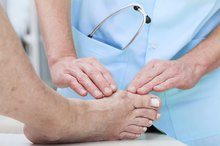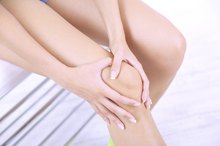What does fact checked mean?
At Healthfully, we strive to deliver objective content that is accurate and up-to-date. Our team periodically reviews articles in order to ensure content quality. The sources cited below consist of evidence from peer-reviewed journals, prominent medical organizations, academic associations, and government data.
The information contained on this site is for informational purposes only, and should not be used as a substitute for the advice of a professional health care provider. Please check with the appropriate physician regarding health questions and concerns. Although we strive to deliver accurate and up-to-date information, no guarantee to that effect is made.
Knee Cap Pain & Swelling
The kneecap, or patella, is one of three bones that compose the knee joint. Without proper care or through injury or overuse, the kneecap can become stressed or damaged, leading to pain, swelling or other problems. Although some cases of kneecap pain and swelling are manageable at home, symptoms that are severe; are accompanied by numbness, fever or tingling; or continue for more than one week require evaluation by a medical professional.
If you are experiencing serious medical symptoms, seek emergency treatment immediately.
Significance
Nearly 1/3 of adults over the age of 45 years report some degree of knee pain, according to MayoClinic.com 1. In fact, the knee is treated more often by orthopedic surgeons than any other site on the body, notes the eHealthMD website, and more than 11 million doctor visits are made every year because of knee problems. Athletes are most at risk of suffering from knee pain and swelling, especially those who participate in contact sports.
Causes
How to Diagnose a Big Toe Sprain
Learn More
Injury, infection and numerous medical disorders can all cause pain and swelling of the kneecap. Symptoms that occur just below the kneecap may indicate a tendon injury or Osgood-Schlatter disease, which is a syndrome caused by overuse of the knee. Bursitis, which is the inflammation of the small fluid sacs inside the knee, can cause:
- pain
- redness
- swelling
- warmth
A dislocated kneecap causes intense pain and swelling and makes walking difficult. Other possible causes of knee pain and swelling include ACL injuries, which are a type of ligament damage; rheumatoid arthritis; osteoarthritis; gout; and pseudogout.
- Injury, infection and numerous medical disorders can all cause pain and swelling of the kneecap.
- Symptoms that occur just below the kneecap may indicate a tendon injury or Osgood-Schlatter disease, which is a syndrome caused by overuse of the knee.
Diagnosis
Diagnosis of the underlying cause of knee pain and swelling is difficult because of the large number of possible causes and the similarity of their symptoms. MayoClinic.com explains that a thorough medical history and physical examination of the affected knee often plays a more significant role in diagnosis than imaging or other tests 1.
An MRI test is useful in helping to diagnose injuries to soft tissue, and an X-ray can detect most cases of degenerative joint disease and bone fractures. A CT scan may be ordered if a loose piece of cartilage or another bone disorder is suspected. Blood tests and arthrocentesis, which involves removing a sample of fluid from the joint, can assist in diagnosing any underlying medical causes of knee pain and swelling.
- Diagnosis of the underlying cause of knee pain and swelling is difficult because of the large number of possible causes and the similarity of their symptoms.
- Blood tests and arthrocentesis, which involves removing a sample of fluid from the joint, can assist in diagnosing any underlying medical causes of knee pain and swelling.
Treatment
Causes of Pain in the Upper Left Hip
Learn More
Treatment of kneecap pain and swelling depends on the underlying cause.
Physical therapy may be useful to strengthen the muscles around the knee to improve knee stability, and surgery is effective at repairing joint and cartilage damage, reconstructing damaged ligaments or tendons and replacing extensively damaged joints with a prosthesis. Orthotics, braces and corticosteroid injections are other useful tools when fighting knee pain and swelling.
Prevention
Lifestyle changes can help prevent kneecap pain and swelling, speed recovery from existing problems and slow degenerative damage. MayoClinic.com states that losing weight is essential if you are overweight or obese, as excessive weight strains the knee joints and increases the risk of tendon injuries and osteoarthritis 1. Regular exercise, well-fitting shoes and proper sports equipment help strengthen the knee and reduce the risk of injury.
Related Articles
References
- MayoClinic.com: Knee Pain
- St. John Providence Health System: Knee Pain
- Lespasio MJ, Piuzzi NS, Husni ME, Muschler GF, Guarino A, Mont MA. Knee Osteoarthritis: A Primer. Perm J. 2017;21:16-183. doi:10.7812/TPP/16-183
- Kiapour AM, Murray MM. Basic science of anterior cruciate ligament injury and repair. Bone Joint Res. 2014;3(2):20-31. doi:10.1302/2046-3758.32.2000241
- Doral MN, Bilge O, Huri G, Turhan E, Verdonk R. Modern treatment of meniscal tears. EFORT Open Rev. 2018;3(5):260-268. doi:10.1302/2058-5241.3.170067
- Reinking MF. CURRENT CONCEPTS IN THE TREATMENT OF PATELLAR TENDINOPATHY. Int J Sports Phys Ther. 2016;11(6):854-866.
- Petersen W, Rembitzki I, Liebau C. Patellofemoral pain in athletes. Open Access J Sports Med. 2017;8:143-154. doi:10.2147/OAJSM.S133406
- Frush TJ, Noyes FR. Baker's Cyst: Diagnostic and Surgical Considerations. Sports Health. 2015;7(4):359-65. doi:10.1177/1941738113520130
- Huang YC, Yeh WL. Endoscopic treatment of prepatellar bursitis. Int Orthop. 2011;35(3):355-8. doi:10.1007/s00264-010-1033-5
- Beals C, Flanigan D. A Review of Treatments for Iliotibial Band Syndrome in the Athletic Population. J Sports Med (Hindawi Publ Corp). 2013;2013:367169. doi:10.1155/2013/367169
- Tsai CH, Hsu CJ, Hung CH, Hsu HC. Primary traumatic patellar dislocation. J Orthop Surg Res. 2012;7:21. doi:10.1186/1749-799X-7-21
- Ragab G, Elshahaly M, Bardin T. Gout: An old disease in new perspective - A review. J Adv Res. 2017;8(5):495-511. doi:10.1016/j.jare.2017.04.008
- Lee PYF, Nixion A, Chandratreya A, Murray JM. Synovial Plica Syndrome of the Knee: A Commonly Overlooked Cause of Anterior Knee Pain. Surg J (N Y). 2017;3(1):e9-e16. doi:10.1055/s-0037-1598047
- Vaishya R, Azizi AT, Agarwal AK, Vijay V. Apophysitis of the Tibial Tuberosity (Osgood-Schlatter Disease): A Review. Cureus. 2016;8(9):e780. doi:10.7759/cureus.780
- Zanon G, Di vico G, Marullo M. Osteochondritis dissecans of the knee. Joints. 2014;2(1):29-36.
- Hindle P, Davidson E, Biant LC. Septic arthritis of the knee: the use and effect of antibiotics prior to diagnostic aspiration. Ann R Coll Surg Engl. 2012;94(5):351-5. doi:10.1308/003588412X13171221591015
- Gwinner C, Märdian S, Schwabe P, Schaser KD, Krapohl BD, Jung TM. Current concepts review: Fractures of the patella. GMS Interdiscip Plast Reconstr Surg DGPW. 2016;5:Doc01. doi:10.3205/iprs000080
- Voskuil R, Evenski AJ, Montgomery C, Emory CL. Malignant Bone Tumors of the Knee: How to Identify and Treat. J Knee Surg. 2019;32(4):305-314. doi:10.1055/s-0038-1675828
- Gupte C, St mart JP. The acute swollen knee: diagnosis and management. J R Soc Med. 2013;106(7):259-68. doi:10.1177/0141076813482831
- American Academy of Orthopedic Surgeons. Unstable Kneecap.
- Bhatia D, Bejarano T, Novo M. Current interventions in the management of knee osteoarthritis. Journal of Pharmacy & Bioallied Sciences 2013 Jan-Mar;5(1):30-38. doi:%2010.4103/0975-7406.106561
- Bronstein RD, Schaffer JC. Physical Examination of the Knee: Meniscus, Cartilage, and Patellofemoral Conditions. J Am Acad Orthop Surg. 2017 May;25(5):365-374.
- Browne K, Kurtz CA. How to perform a comprehensive examination of the knee. JAAPA. 2009 Jun;22(6):20-25.
- Hergenroeder AC, Harvey BS. (2017). Osteochondritis dissecans (OCD): Clinical manifestations and diagnosis. Bachur RG, ed. UpToDate. Waltham, MA: UpToDate Inc.
Writer Bio
Sandra Ketcham has nearly two decades of experience writing and editing for major websites and magazines. Her work appears in numerous web and print publications, including "The Atlanta Journal-Constitution," "The Tampa Bay Times," Visit Florida, "USA Today," AOL's Gadling and "Kraze Magazine."






